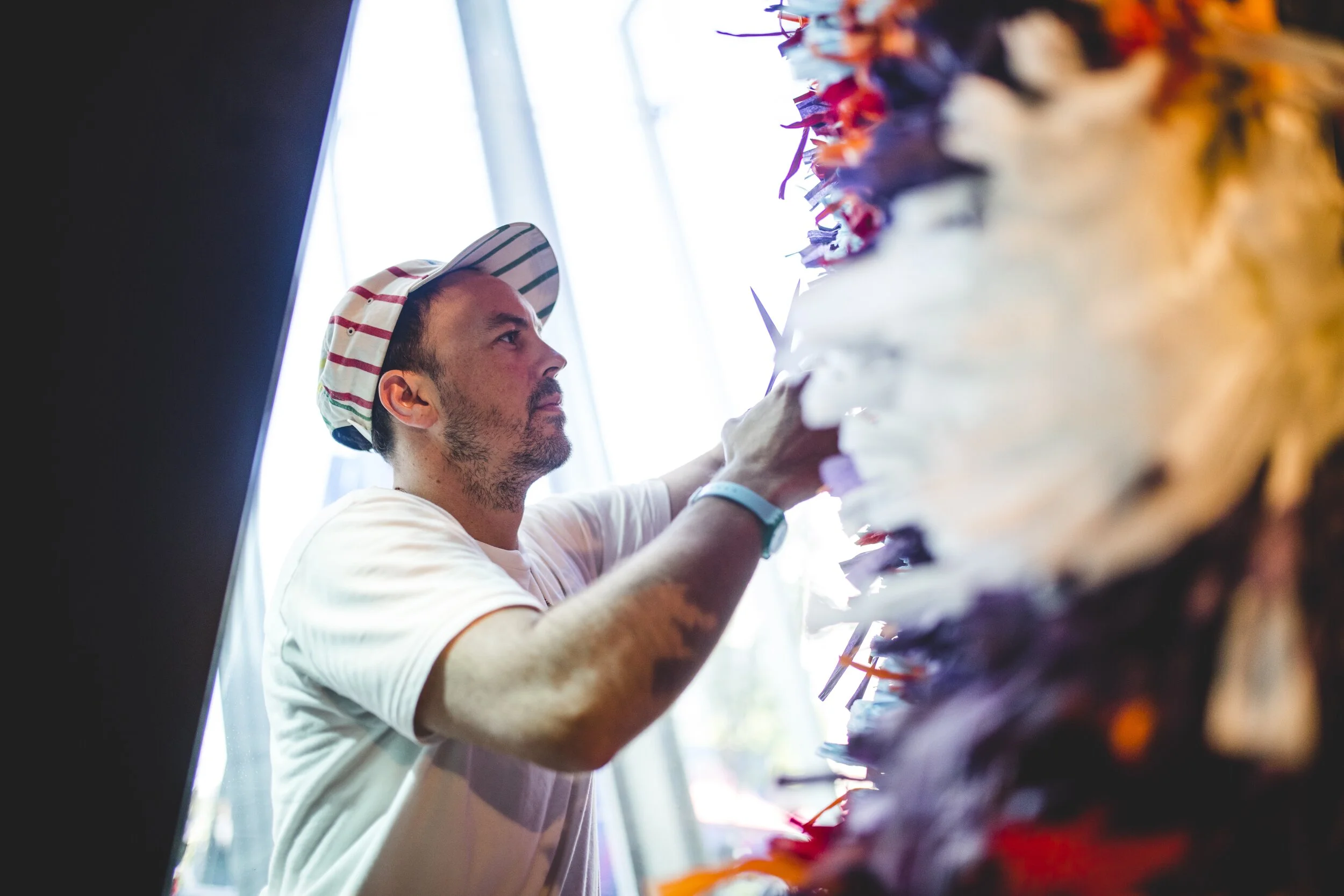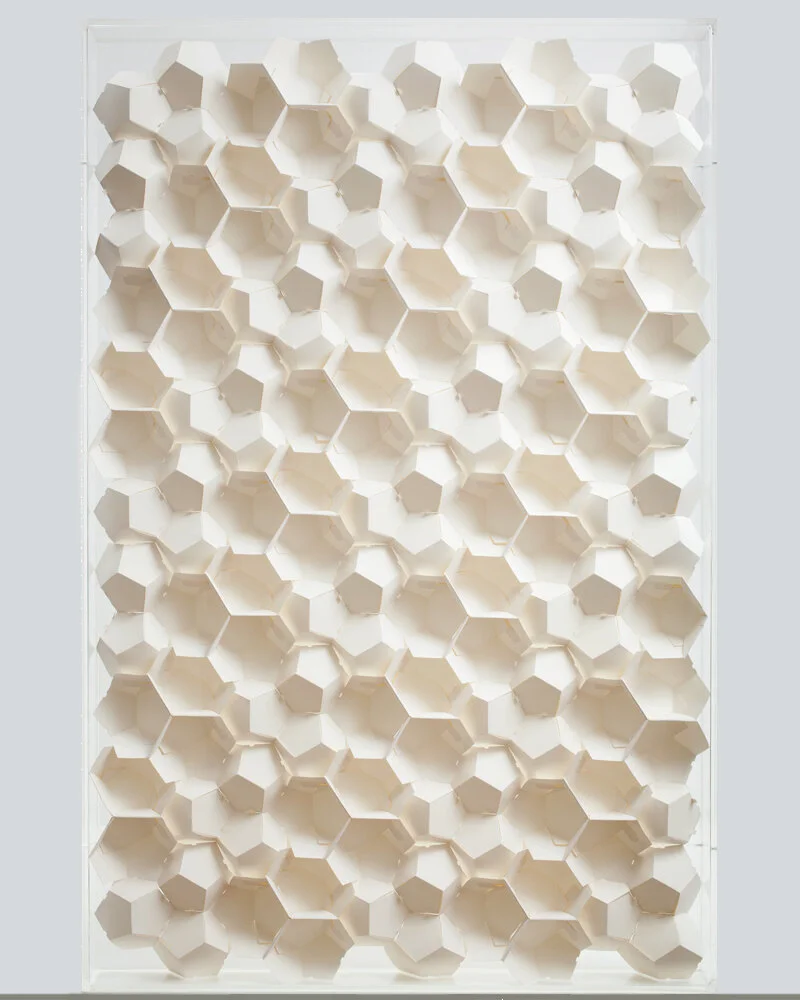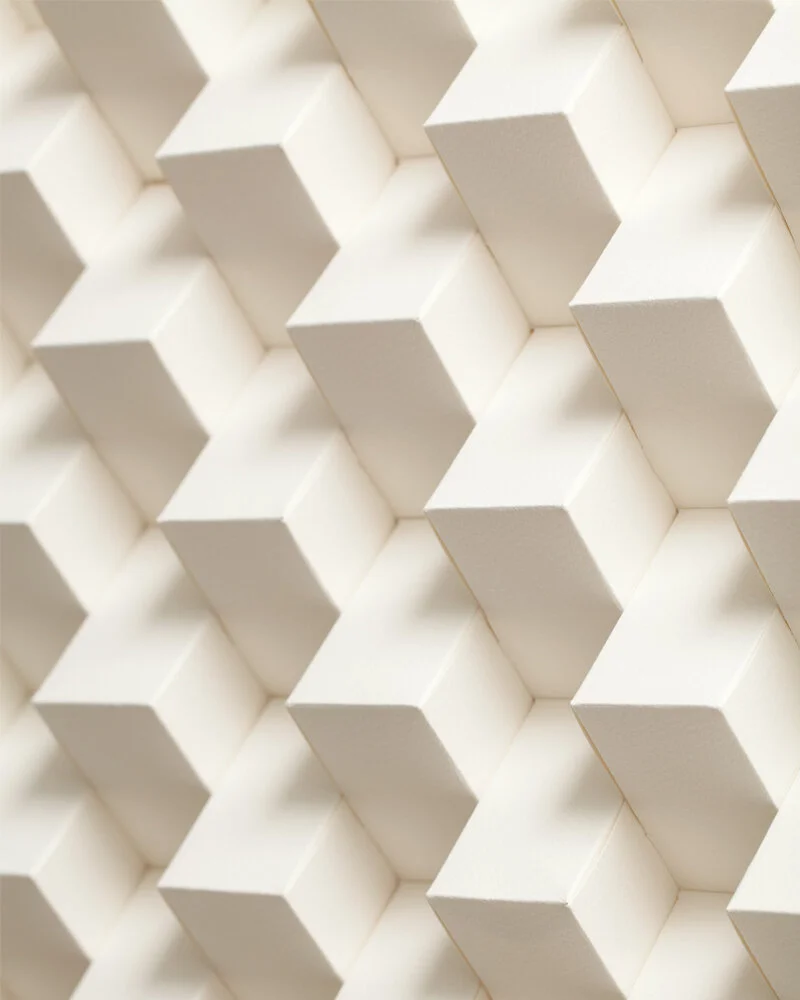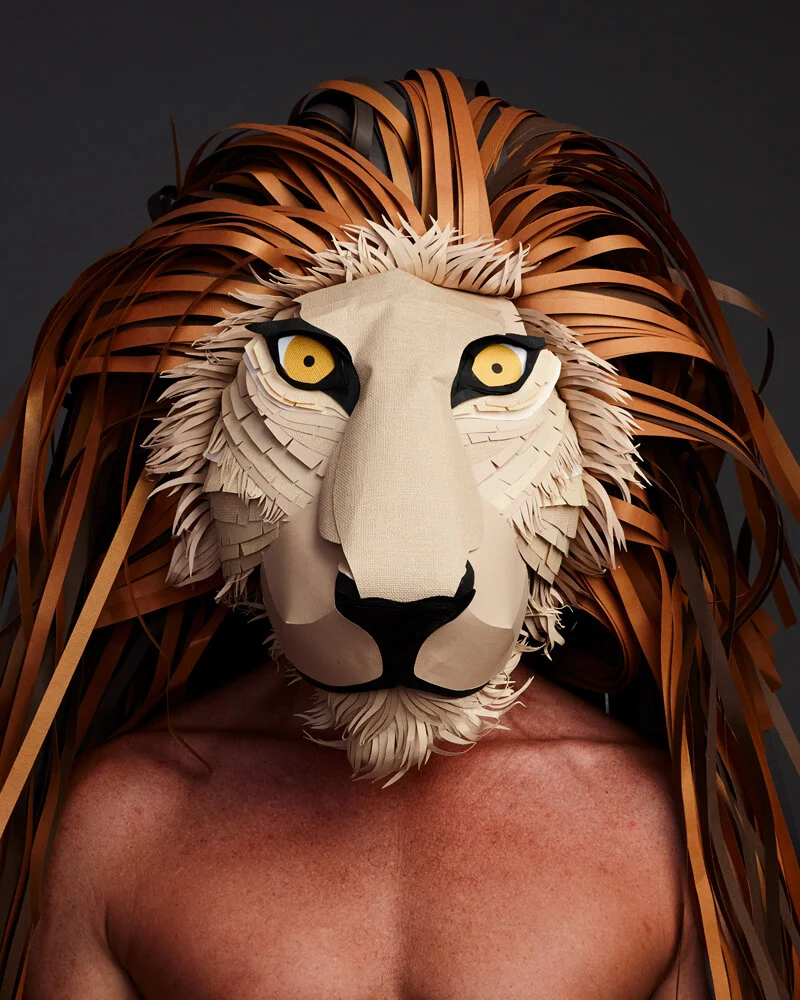Benja Harney
paper engineer
Benja Harney working on Sydney installation – The Streets of Barangaroo. Photo: Billy Zammit
Interview by Peter Salhani | Photography by Billy ZAmmit
Benja Harney is a paper engineer working with global brands – Google, Samsung, Nike, Hermés and Sydney Opera House, to name a few. As a graphic designer with a mind for the mechanics of things, Benja found that working with paper reawakened his childhood memories of ‘making’ by hand. Since committing to his craft, the world has come knocking.
How did you get into paper engineering?
I was studying graphic design at Enmore College in about 2003. We had a class called paper construction. My teacher was into paper engineering, although we didn’t know it was called that. We had to make things like simple pop-up mechanisms, a folder for your CD-Roms (back in the day). It was something I really enjoyed doing, and I kind of fell in love with paper.
What made you fall in love with paper?
I think it was the memory of being young. My dad’s an engineer. As kids we were always making and building things: model airplanes, Lego. At the time I was studying graphic design, it had a very digital focus, but there was also a new wave emerging where physical objects were becoming important. So when I discovered that I could make tangible objects as part of graphic design, I got really interested. I was just in the right place at the right time.
Weaving paper raffia for The Streets of Barangaroo installation in Sydney. Photo: Billy Zammit
“It was the memory of being young.”
Hermés Christmas 2009 windows in Sydney by Studio Paperform.
Your first paper commission?
I’d been working as a graphic designer with a newspaper. Around 2006, a stylist friend of mine, Megan Morton, asked me to do a series of paper sculptures for a Christmas photo shoot for Travel & Leisure. We made mini sets to stage ‘gift ideas’. That was the first time my work was published. Then, for a few years after, I did both – graphic design during the day, then at nights and on weekends, paper.
“You only get one shot to work with a company like that.”
The breakthrough gig?
In 2009, I created a pop-up book with the editor of Harpers Bazaar, as a talking point to show advertisers in the lead-up to the big September issue. From that, I got a commission from Hermés in Sydney for its Christmas window displays. We made a series of angel wings in bright colours. It took about thirty days to make seven pairs. That was really ‘the moment’. You only get one shot to work with a company like that; so I just pushed the boat out and went for it! They’ve since invited me several times to Paris to work with them.
Hermés Christmas 2009 windows in Sydney by Studio Paperform.
So networking has been important
Yes. I’m lucky to have a lot of interesting, creative people as friends, in the arts, design, fashion, which is how I’d get those first few gigs. I’m very social and outgoing; that helps. But also word of mouth and the Internet made things happen for me. Photo sites like Flikr meant my work was seen around the world.
Is paper a puzzle for you?
Most certainly. I’m very inquisitive; I like to know how things work. So I like the process of problem-solving and streamlining my approach; I don’t like repeating myself. I also enjoy the challenge of making things – like pop-up books – they’re a whole other level of complexity, because the object’s got to move. Those commissions are rare because they take a lot of time and money to produce.
Interlocking units (above) woven into geometric tapestries (no glue), from Benja Harney’s New Platonic exhibition (2012) at the NGV.
What’s the appeal of pop-up books?
They’re kind of magical, aren’t they? One minute they’re flat, the next, they’re not. And they’ve got a lovely scale, but they’re bloody hard work: you go into this whole other brain world. Whiskey helps.
Do you work in other mediums?
I’ve done projects with all sorts of material. Anything that folds like paper. A few years ago I went to Paris and did a pop-up book for Hermès in leather.
Pop-up book by Studio Paperform for Australian Catholic University’s Impact Through Empathy project.
“You go into this whole other brain world.”
Tiger mask from Big Cats, by Studio Paperform for Hermés.
Your biggest challenge?
You don’t learn how to run a business at design school, you learn how to be creative. So, I waded into the world of trademarks unprepared, but you learn about business by making mistakes. That’s part of the design process too, so I enjoy it all.
Most loved projects?
I did the branding for the City of Sydney New Year’s Eve 2016 celebrations. I modelled the Sydney skyline in paper and it was projected on the Harbour Bridge and all around the city*. As someone from Sydney, I felt honoured to be asked. A billion people saw my work.
I’ve loved doing objects for Mardi Gras and the Sydney Opera House, and I’ve collaborated on pop-up books with Kylie Minogue, and another with Katherine Sabbath – the Insta-famous baker.
Artwork (above) by Studio Paperform for Taste Food Festival (2017).
I just love all my projects – they’re quite varied. I work with interior designers, architects, festivals. I especially love the fashion projects – I’ve done a lot of props for photo shoots, and paper dresses things like that. Fashion people were really the first ones to come knocking, and fashion is also very important to me personally; I think a lot about what to wear every day. It makes me happy.
[*Studio Paperform’s Sydney NYE became Object No. 175 in the City’s list of iconic objects over 175 years].
Lion mask from Big Cats, by Studio Paperform for Hermés.
Essential tools of your trade?
Well, the hands and the brain: these are amazing tools. And: medical scalpels; glue, paper clips, rulers, hole punch, scissors, tape. Computer and printer: though I don’t use the computer to design, it’s just a drawing tool that allows me to get very precise measurements and print things out on repeat.
“I like that they’re ephemeral... it makes them more precious in a way.”
How do you refuel?
I like going into ‘the cave’: staying home, cooking and trimming my bonsai. I have a lot of bonsai figs and Boddhi trees (Ficus Religiosa), you know, the tree the Buddha sat under and attained enlightenment. I’ve been propagating a few of them as gifts for friends.
NGV Book Fair (2017) installation by Studio Paperform.
What's next?
I’m working with [Danish textile producer] Kvadrat on an installation for the (now postponed) Milan Furniture Fair. I’ve also been planning a little offshoot of the studio, so that people can enjoy the work without having to commission large projects. The whole premise is paper only, no plastic. We don’t use plastic in our installations, and we use as little as possible in construction.
Is your paper sustainable/ethical?
Yes. We mostly use paper from a British company, GF Smith. When the forests they source from are harvested, the good wood goes to making furniture etc, and GF Smith gets all the branches and stuff that would otherwise go to waste; that’s what they make their paper from. That’s the other thing I like about paper: it’s recyclable.
Cheetah mask from Big Cats by Studio Paperform for Hermés.
Does it bother you that they’re ephemeral?
No, I like that about them. Paper is a very delicate material (particularly if it gets wet), but it can also last a thousand years if it’s taken care of. Think about all the historic books we have. So I like the idea of it being ephemeral; things don’t need to be permanent. We aren’t. That makes them more precious in a way, because you know you have to take care of them.


















